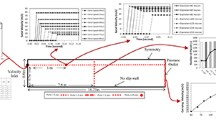Abstract
A model, coupling metrological dynamic model MM5 and dust transport model, is developed for the atmosphere-particle two phases flow of dust storm. The simulations of the dust storm events in north China with a geographic information database are performed using the model, and represent an overview of dust transport pathways and particles concentration distribution over the north China. The comparison between computations and practical observations shows that the simulations succeed in description of dust storm evolvement and particle transport behavior. Based on the computations and analysis, the characteristics of particle transport, especially well-concerning the factor of the particle thermal diffusion, are studied. A new definition of mass transfer Grd is put forward to discover the internal principle of particle thermal diffusion at various atmospheric layers. Several phenomena, such as thermal diffusion item QT–Grd distribution, and relationships, Particle Grd probability function, are obtained. The investigation indicates particle thermal diffusion can be not ignored in mesoscale atmospheric-particle multiphase flow.









Similar content being viewed by others
References
Reheis MC, Budahn JR (2002) Geochemical evidence for diversity of dust sources in the southwestern United States. Geochimica et Cosmochimica Acta 66(9):1569–1587
Tindale NW (1999) Aerosols over the Arabian Sea: atmospheric transport pathways and concentrations of dust and sea salt. Deep-sea Res II 46:1577–1595
Knight AW (1995) Sediment loads in an Australian dust storm: implications for present and past dust process. Catena 24(3):195–213
Zhang D, Iwasaka Y (1999) Nitrate and sulfate in individual Asian dust-storm particles in Beijing, China in spring of 1995 and 1996. Author Atmos Environ 33:19
Gomes L, Gillette DA (1993) Comparison of characteristics of aerosol from dust storms in Central Asia with soil-derived dust from other regions. Atmos Environ Part A Gen Top 27A(16):2539–2544
Ma C-J (2001) Characteristics of single particles sampled in Japan during the Asia dust-storm period. Atmos Environ 35(15):2707–2714
Butler HJ, Hogarth WL, McTainsh GH (1996) A source-based model for describing dust concentrations during wind erosion events: an initial study. Environ Software 11(1–3):45–52
Goudie AS, Middleton NJ (2001) Saharan dust storms: nature and consequences author. Earth-Sci Rev 56:179–204
Chen W, Fryrear DW (2002) Sedimentary characteristics of a haboob dust storm. Atmos Res 61(1):75–85
Chernova EA (1996) Deformation of aerosol particle size distribution under the condition of laminar movement through a flat channel with temperature variation. J Aerosol Sci 27(suppl 1):s285
Ganor E (1996) The deposition flux and velocity of the sahara aerosol to the ground in Israel. J Aerosol Science 27(5):824
Ta-Hsiung L (2001) Long-range transport of yellow sand to Taiwan in spring 2000: observed evidence and simulation. Atmos Environ 35:5873–5882
The NCAR/Penn State Fifth-Generation Mesoscale Model (2002)
Anthes R, Warner (1994) Description of the Penn State/NCAR Mesoscale Model Version, NCAR, March
Waldmann L, Schmitt KH (1966) Thermophoresis and diffusiophoresis of aerosol, Chap VI. In: Davies CN (ed) Aerosol science. Academic, New York
Kennard EH (1938) Kinetic Theory of Gases, McGraw-Hill, New York. A good discussion of the creep velocity at a particle surface resulting from a temperature gradient in the carrier gas is given on pp.327 ff
Soo SL (1989) Particulates and continuum multiphase fluid dynamics. Hemisphere, New York (Epstein PS (1924) Phys Rev 23:710)
Yamartino RJ, Scire JS, Carmichael GR, Chang YS (1992) Calgrid mesoscale photochemical GRID model. I model formulation. Atmos Environ 26A:1493–1512
China Dust Storm Research Center (CDSRC) (2002) http://www.duststorm.com.cn
Bird RB, Stewart WE, Lightfoot EN (2002) Transport phenomena, 2nd edn. Wiley, New York
Allen T (1981) Particle size measurement, 3rd edn. Chapmen and Hall, London
Acknowledgments
This research is supported by the Major Program of Nature Science Foundation of China (No. 59995460) and the Major Fundamental Research Program of Ministry of Science and Technology Of China (No. G1999022209).
Author information
Authors and Affiliations
Corresponding author
Rights and permissions
About this article
Cite this article
Wang, X., Wang, T., Tang, J. et al. Thermal diffusion characteristics of atmosphere-particle two phase flow in dust storm. Heat Mass Transfer 41, 306–314 (2005). https://doi.org/10.1007/s00231-004-0533-5
Received:
Published:
Issue Date:
DOI: https://doi.org/10.1007/s00231-004-0533-5




